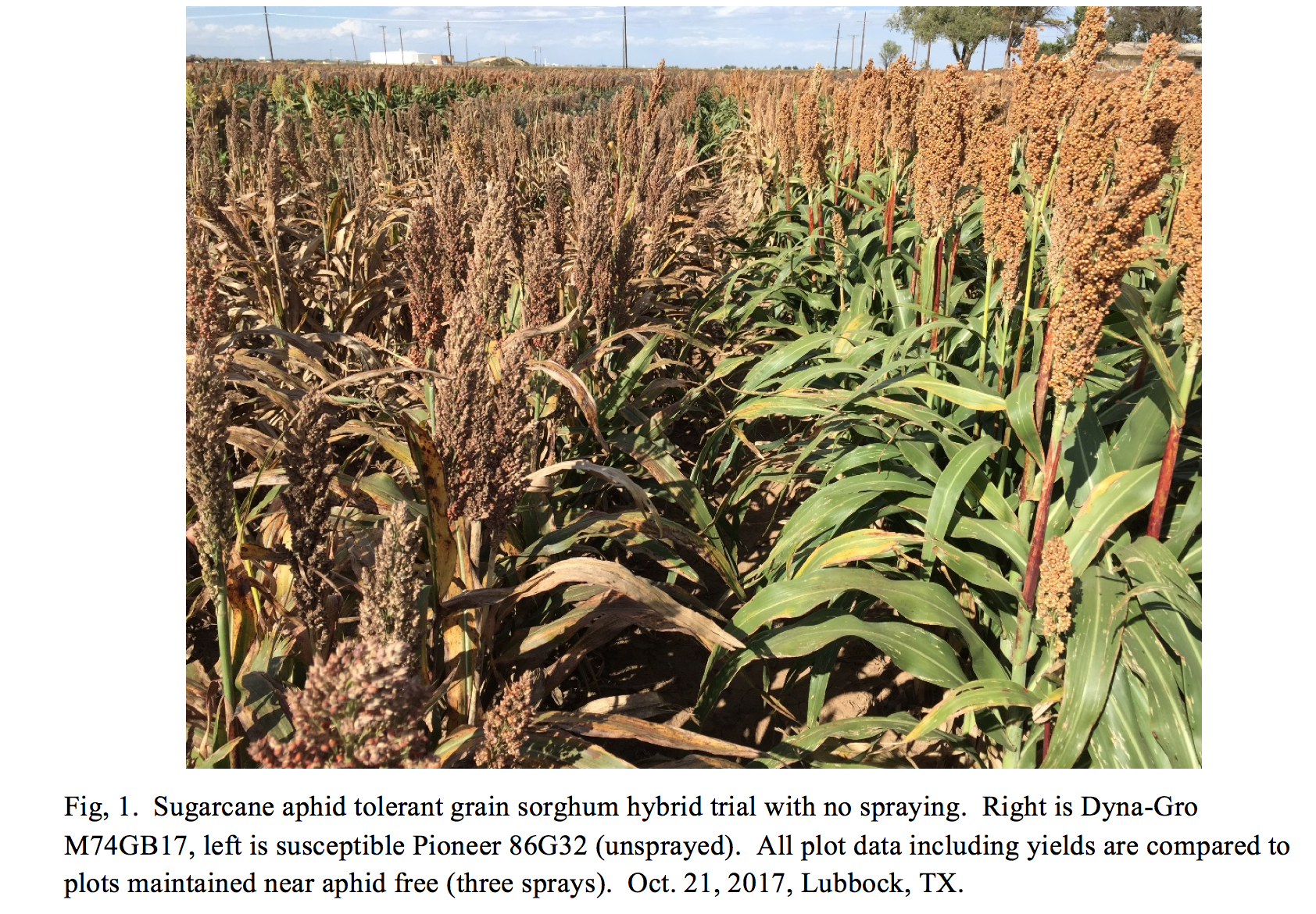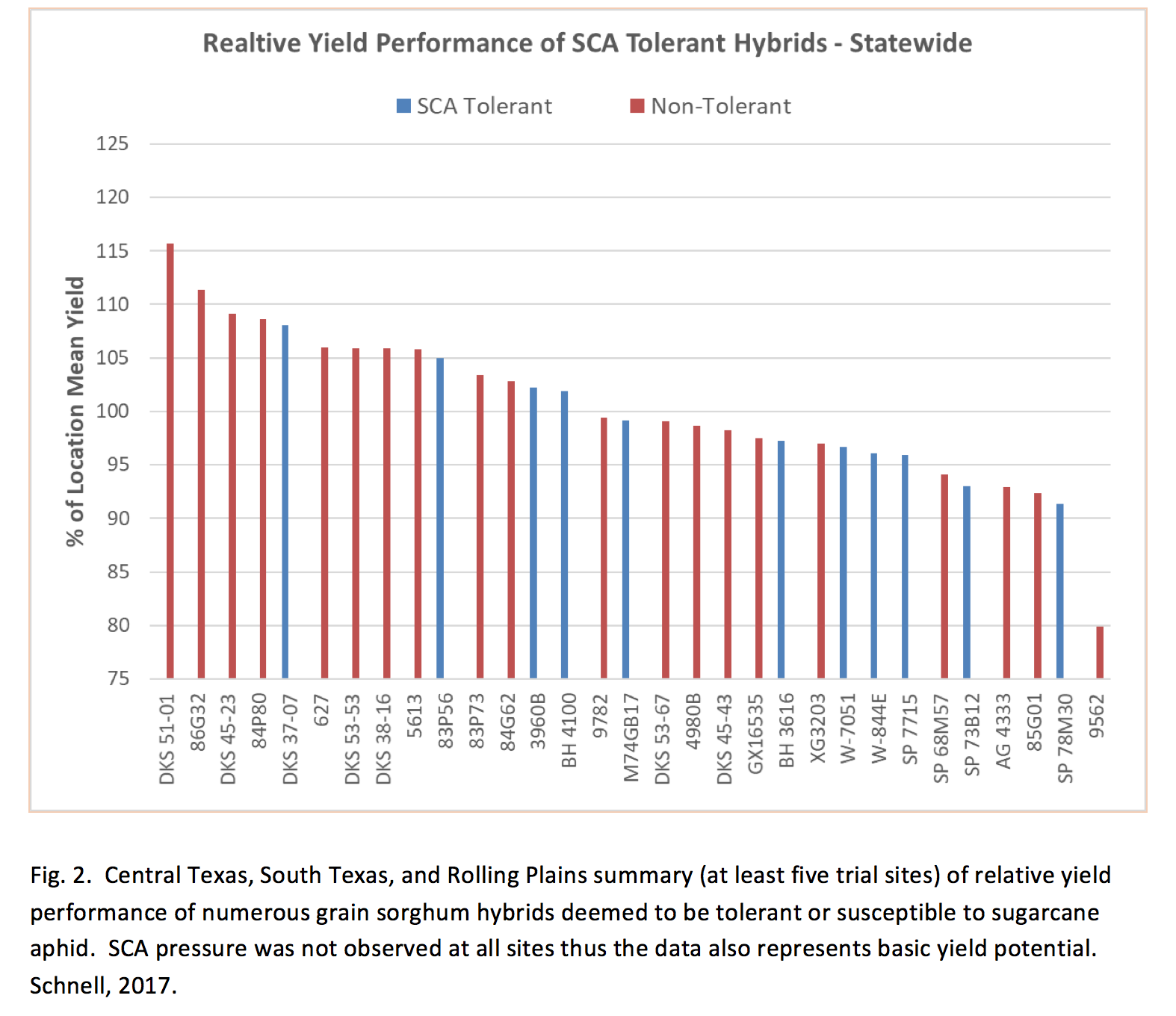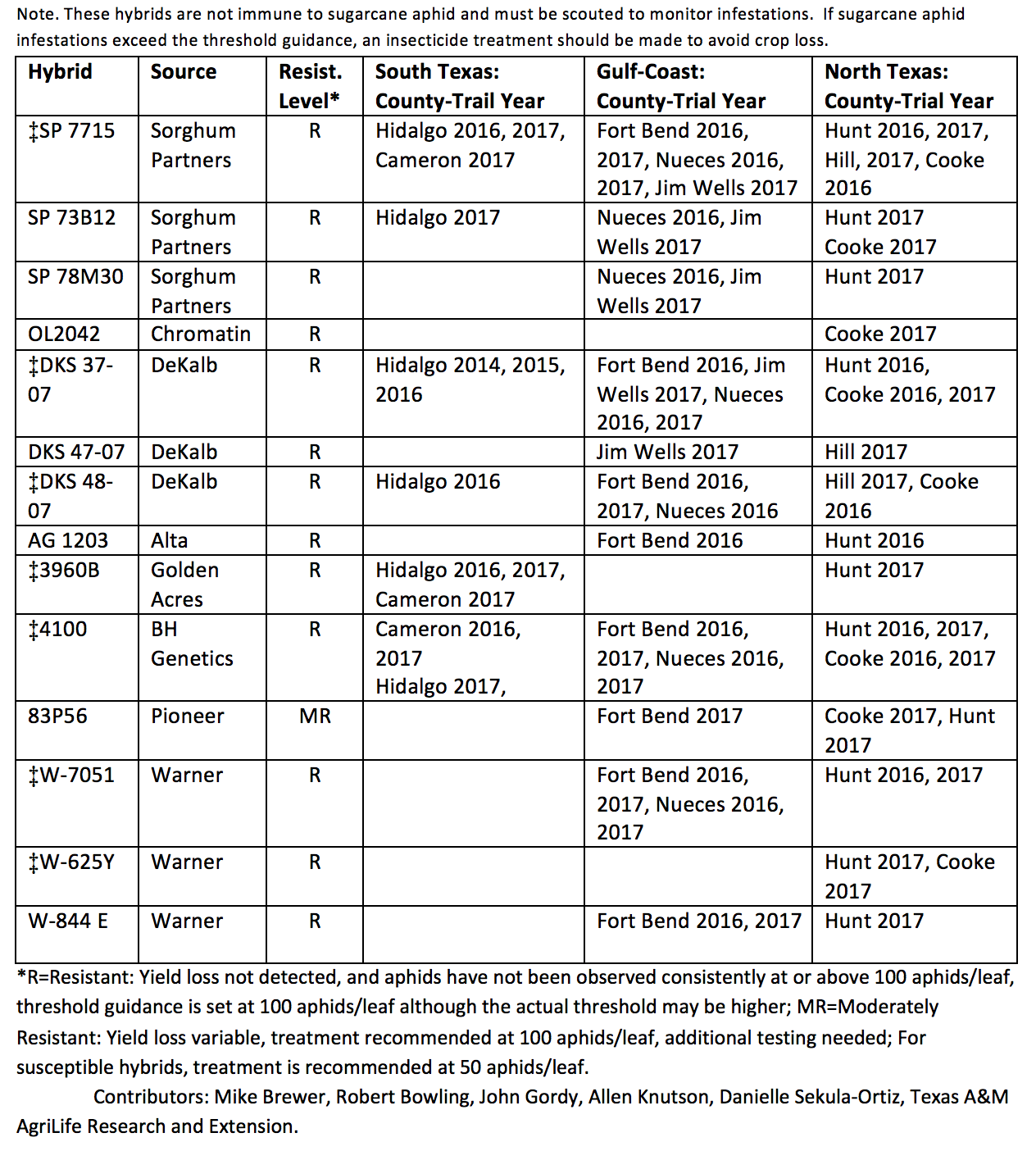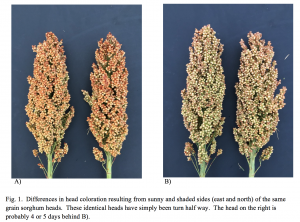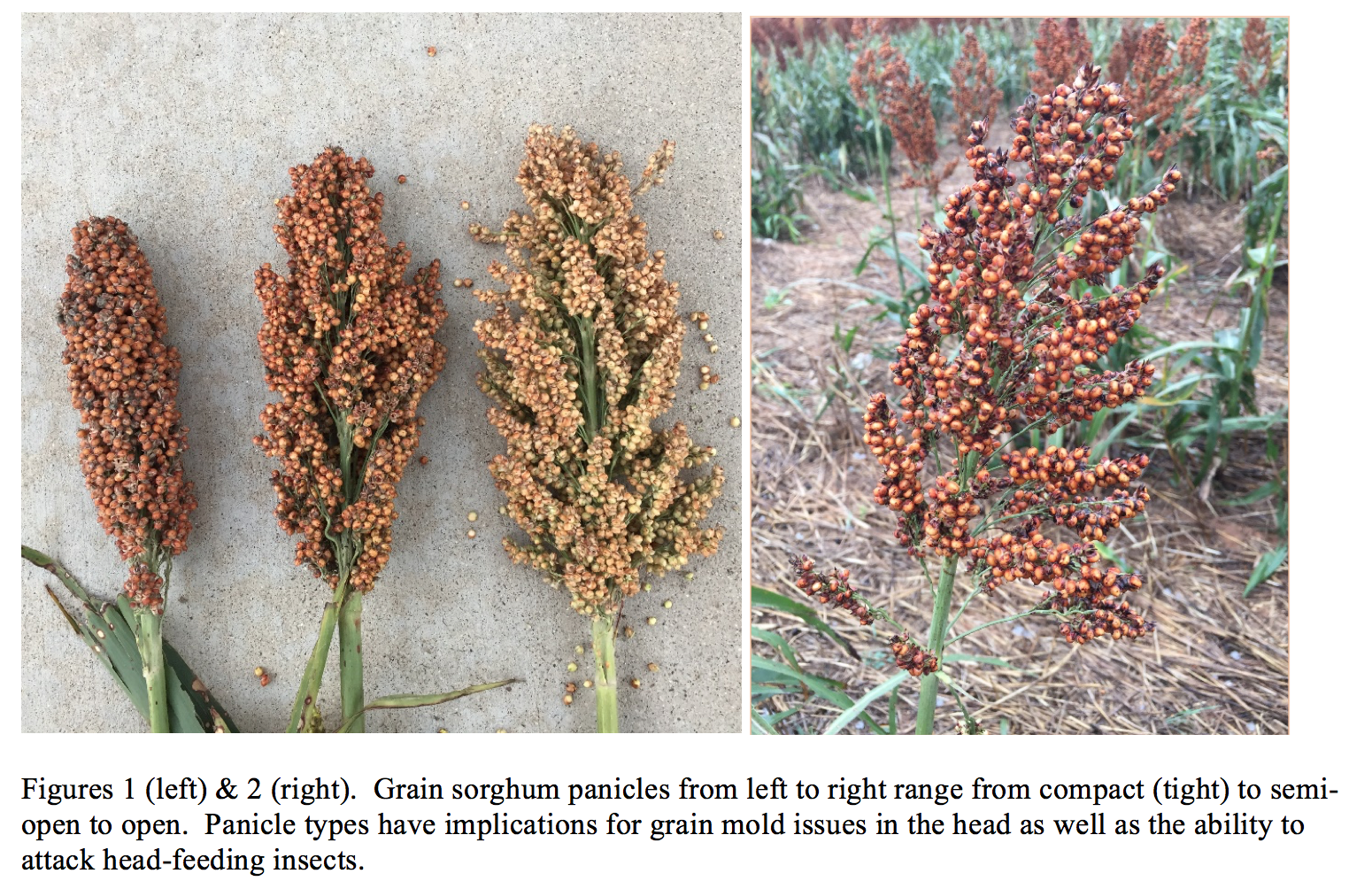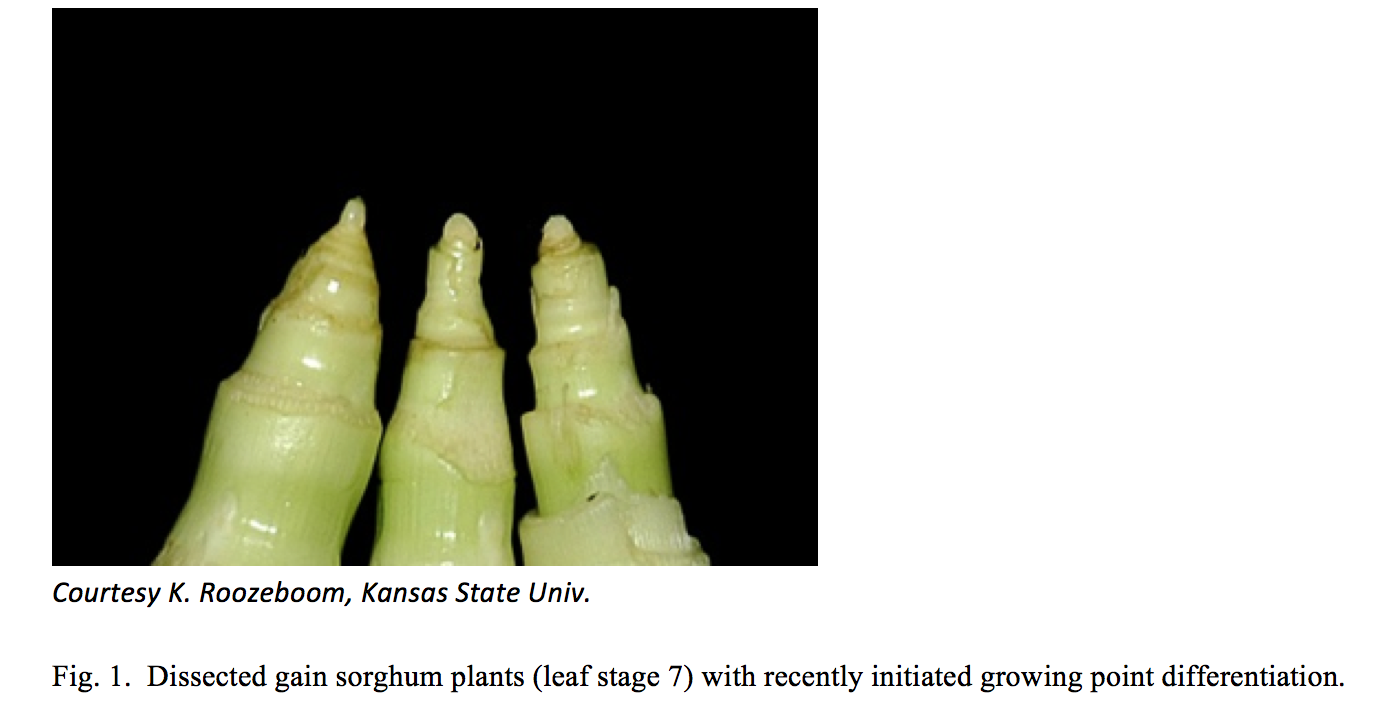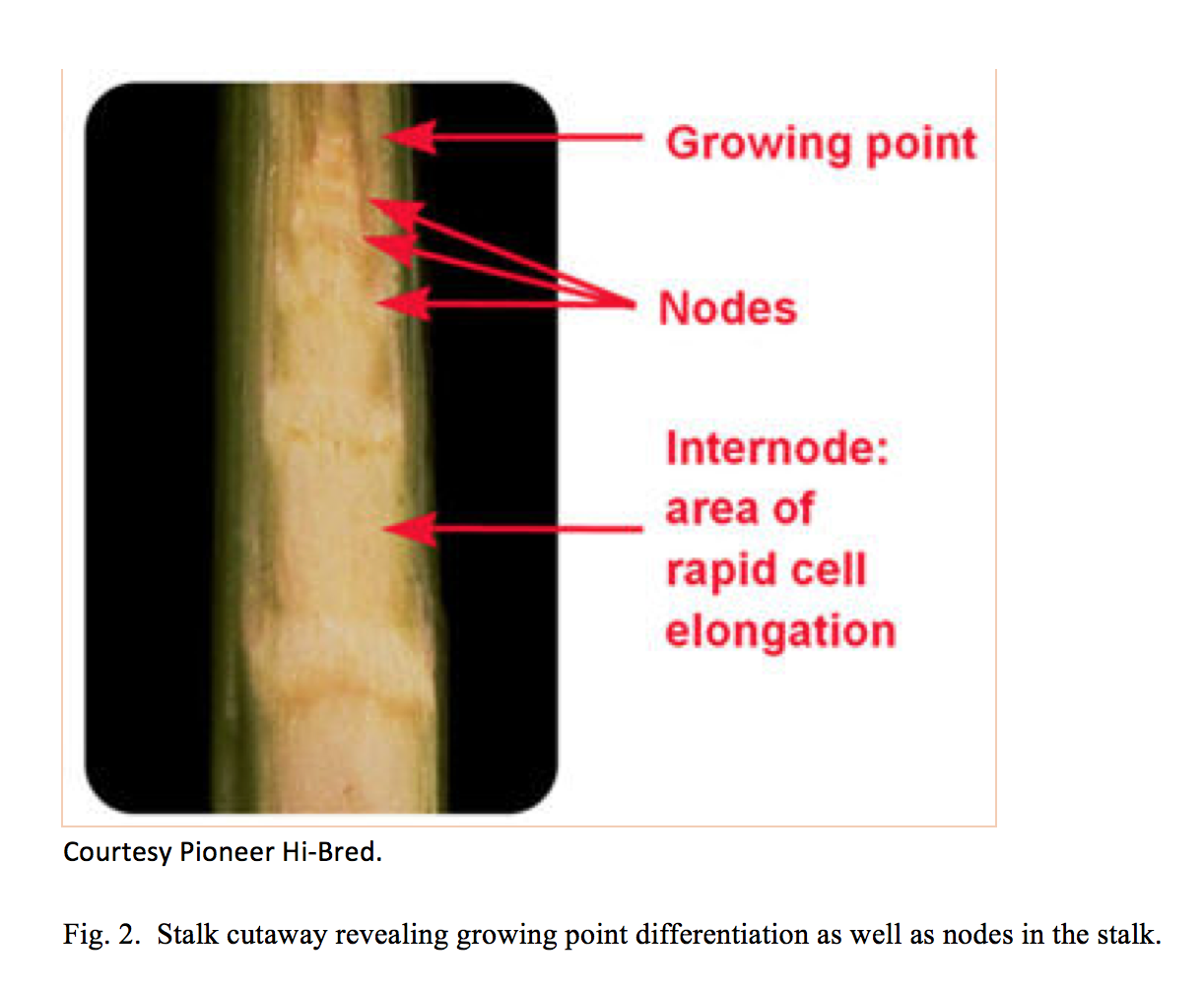Where has Sugarcane Aphid Been Reported in 2018?—SCA Tracker Map
Statewide
With some grain sorghum harvest beginning, sugarcane aphid is an afterthought for much of the grain sorghum grown in the Lower Rio Grande Valley. Sorghum growers further north, where some sorghum has yet to be planted, have a long way to go in terms of if and when SCA may infest their grain crop.
Several state extension and industry partners collaborate to provide verified information about the presence of SCA on a county by county basis. So far in 2018 almost all SCA reports have been either on the Texas Gulf Coast or one county removed from the coast. Three weeks ago there were only two counties more distant (Uvalde and Caldwell) from the Gulf Coast that had SCA reports. Since then, at least nine more counties in a continuous band north to Ellis Co., Texas are now reporting sugarcane aphid. Also, and potentially worrisome, SCS is reported in Kiowa Co. in southwest Oklahoma (early planted field that has headed).
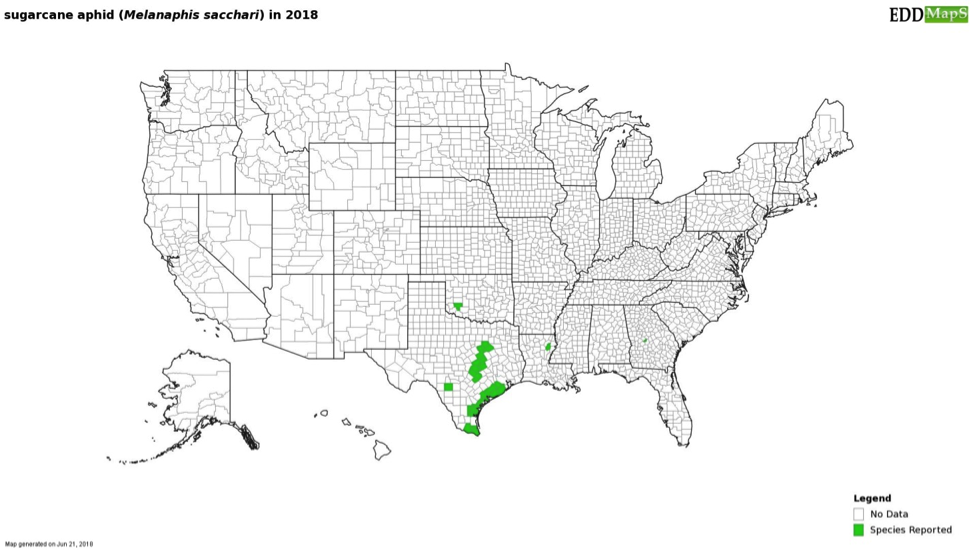
An SCA report is the presenceof SCA—whether one aphid or thousands—on grain sorghum, haygrazer, or perhaps on Johnsongrass. If a county is shaded green (below), it could range from a single report to several, but once a county is positive for SCA, it doesn’t matter if more sightings are reported. Many counties in the U.S. in previous years were never shaded green because no one bothered to check or to report. If counties north of you have reported SCA, then they are probably present somewhere in your area.
To follow the SCA tracker more closely check the map weekly at https://www.myfields.info/pests/sugarcane-aphid If you find SCA in your county (not yet reported) on grain sorghum or other susceptible host, you can note the observation to an AgriLife Extension IPM agent or Dr. Allen Knutson, Extension entomologist, Texas A&M AgriLife, Dallas, allen.knutsen@ag.tamu.edu, office (972) 952-9222. Ideally, a photograph that records the date and location of the sighting is preferred.
Grain Sorghum & Hail Injury Assessment
This tip was provided by:
Calvin Trostle, Extension Agronomy, Lubbock, 806-746-6101, ctrostle@ag.tamu.edu
Statewide
Grain Sorghum & Hail Injury Assessment
It is that time of year when the rain we so often need is accompanied by hail. Corn hail injury assessment resources are more readily available than grain sorghum, but there is literature published to help producers with initial assessment in terms of what yield losses might be for grain sorghum as well. I have looked at several fields over the years that the degree of sorghum leaf loss looks devastating (and it is), but in fact, the yield potential may not be reduced that much.
An older Texas Extension document entitled “Assessing Hail and Freeze Damage to Field Corn and Sorghum,” (EB-6014; available for free download at http://www.agrilifebookstore.org ) provides some simple tables that estimate grain sorghum yield reduction due to leaf loss (most of the document is about corn, but see page 6 for grain sorghum).
Crop insurance industry guidelines are more complex and will look at stand reduction, stand reduction due to hail, leaf loss, and grain loss in headed sorghum after soft dough. Those methods are more detailed and probably beyond what most producers need. If you would like to learn more about these other stages of hail damage on grain sorghum, Univ. of Nebraska Extension summarizes the losses in document EC129, “Evaluating Hail Damage to Grain Sorghum,” which you can read/print/download from http://extensionpublications.unl.edu/assets/pdf/ec129.pdf
For the leaf loss in grain sorghum, AgriLife’s EB-6014 two key tables are as follows:
Table 3 is for younger grain sorghum is generally intended for pre-boot sorghum (~70 days in much of Texas would be after flowering for a medium maturity hybrid in the High Plains.
For early assessment of grain sorghum hail damage you may initially think that it looks really bad, but often the damage is not as bad as it looks. The earlier the leaf loss, then impact on yield will be less. Many hail-damaged fields are often “keepers”, just let it grow. (Fungicide applications to prevent opportunistic fungal infections are probably not merited.) For young sorghum before about leaf stage 7, the growing point is still below the soil line thus near total leaf loss has only a small reduction in yield potential. Using Table 3 above, here is an example that requires us to estimate potential leaf loss:
Medium maturity hybrid (half bloom about 65 days in much of Texas) has a 50% leaf loss at 45 days. Those numbers aren’t on the table, but by splitting the losses at 30 and 60 days and plant age of 37 and 51 days, I estimate that the potential yield loss would be about 15%. That is a stand you would keep. Unfortunate, but not devastating.
If you have hail damage but need assistance, contact us at Texas A&M AgriLife. Even field pictures of typical plants can help us assess initially the status of the field and what grain yield potential remains.
Grain Sorghum Hybrid Tolerant Hybrids—Expanded List, USCP
This tip was provided by:
Calvin Trostle, Extension Agronomy, Lubbock, 806-746-6101, ctrostle@ag.tamu.edu
Statewide
Grain Sorghum Hybrid Tolerant Hybrids—Expanded List, USCP
United Sorghum Checkoff Program director of agronomy Dr. Brent Bean has updated his annual list of tolerant grain sorghum hybrids. Dr. Bean notes directly on the USCP website:
“The (link) lists those sorghum hybrids that have been identified over the last two years that have tolerance to sugarcane aphid based on university and other independent trials. All the hybrids listed are being marketed by their respective seed companies as sugarcane aphid tolerant. This is not a complete list and companies may be promoting additional hybrids as sugarcane aphid tolerant. Only those hybrids that have been identified as tolerant by a third party have been included here. Research has shown that sugarcane aphids reproduce slower on tolerant hybrids and in some cases, hybrids are able to withstand a higher sugarcane aphid population without a reduction in yield compared to susceptible hybrids. Tolerant hybrids have been shown to delay when sugarcane aphids may reach the economic threshold. Growers, however, should scout and apply an insecticide to tolerant hybrids if and when the economic threshold is reached. In some cases, multiple applications of insecticide may be necessary.”
There are 52 hybrids among breeding and seed companies. An earlier Sorghum Tip noted which hybrids have received specific testing by Texas A&M AgriLife staff. See the March 9 Tip at http://texassorghum.org/sorghum-tips
All sorghum hybrids identified as SCA tolerant in the above Sorghum Tip tested by Texas A&M AgriLife are listed in the USCP list with one exception. Pioneer 85Y34 was strongly tolerant in Texas A&M AgriLife trials at Lubbock as well as Oklahoma State Univ. Also, we share that Texas A&M AgriLife has found some hybrids have varying tolerance depending on the location. For example, Dekalb DKS 37-07 appears to be less tolerant in the Texas High Plains than downstate.). All hybrids designated in the above link by Texas A&M AgriLife entomologists based their trial results only on tests from the Texas Coastal Bend to Dallas (not the Texas High Plains).
View the current United Sorghum Checkoff Program list of tolerant hybrids at http://www.sorghumcheckoff.com/farmer-resources/grain-production/hybrid-selection Again, not all hybrids that have tolerance to SCA are on this list because there is not yet sufficient third-party data. Ask your seed dealer about their hybrids and which one may fit your needs the best.
Grain Sorghum Hybrid Thresholds to Sugarcane Aphid—No Hybrid Specificity
This tip was provided by:
Calvin Trostle, Extension Agronomy, Lubbock, 806-746-6101, ctrostle@ag.tamu.edu
Statewide
Grain Sorghum Hybrid Thresholds to Sugarcane Aphid—No Hybrid Specificity
In the Feb. 23 issue of TGSA’s “Sorghum Insider” Texas A&M AgriLife Extension entomologists discussed potential options for varying the aphid count on specific hybrids to determine control thresholds. This included raising the threshold to as high as 200 aphids per leaf for grain sorghum hybrids deemed resistant to SCA. This is in contrast to a base level of 50 or 100 aphids per leaf for susceptible lines.
Subsequent grain Sorghum Tips have included additional information pertaining to this option. That guidance was not yet viewed, however, as part of AgriLife Extension entomology’s recommendations.
Recently, Extension entomology decided not to advance any suggestion about differing thresholds to trigger SCA sprays (further research may be conducted). Dr. Allen Knutson, Extension entomologist, Dallas, (972.952.9222, Allen.Knutson@ag.tamu.edu) commented. “We have decided not to promote different thresholds for resistant and susceptible hybrids. Populations of SCA can grow quickly from 50 aphids per leaf on one day to 100 per leaf the next. So fine-tuning a threshold for resistant hybrids is probably not very practical. Also, Extension entomologists on the Texas High Plains do not rely solely on aphid numbers, so this suggested revised threshold using differing SCA numbers is not applicable. Finally, there is concern that some resistant hybrids do not perform as well in the High Plains as they do in south Texas.”
For these reasons, Dr. Knutson notes, AgriLife Extension is revising their forthcoming report and SCA control guidelines.
Also, AgriLife Extension entomologist Dr. Pat Porter, Lubbock (806.746.6101, pporter@ag.tamu.edu) notes that “guidance” (as discussed by AgriLife entomology staff particularly in South Texas) does not mean it has been accepted for our official publications. That is why our new guide will not address thresholds for resistant hybrids. AgriLife Extension now has two SCA treatment thresholds for grain sorghum hybrids. These treat susceptible and resistant hybrids identically. One guideline emphasizes the proportion of plants infested and plus the number of aphids in colonies on leaves. A second guideline will emphasize counting aphids. The former threshold is widely applicable. The latter is likely more applicable in a smaller zone in South Texas. The forthcoming guide will present both approaches, with note of geographic applicability. Readers will be invited to choose which one they prefer.
Another change Dr. Porter notes is the former High Plains SCA threshold has been tweaked for 2018. The action level for pre-boot stage is slightly less conservative (lower number of SCA per leaf) than in the past
We will share the updated entomology information in Sorghum Tips as it becomes available.
Early Postemergence Herbicide Options for Grass Control in Grain Sorghum
This tip was provided by:
Ron Schnell, Cropping Systems – Statewide, College Station, ronschnell@tamu.edu
Statewide
Early Postemergence Herbicide Options for Grass Control in Grain Sorghum
Early competition from broadleaf and grass weeds in grain sorghum can result in yield loss. Use of burndown and soil active herbicides applied before planting or before sorghum emergence is critical for early season weed management. For extended weed control, especially grass control, additional soil active herbicides can be applied to control subsequent flushes of weeds. Other than for InzenTM herbicide tolerant sorghum, no products are labeled for broadcast application and control of emerged grasses in sorghum. Therefore, soil-active herbicides must be applied before subsequent flushes of grass weeds emerge for effective control. Many products limit postemergence applications based on the height of the crop. This generally aligns with growing point differentiation and is intended to reduce crop injury and maximize spray coverage to soil. There are many other options for postemergence control of broadleaf weeds in sorghum and many products can be tank mixed with soil active herbicides that are applied for extended grass control.
Below is a partial list of herbicide options and approximate cost at low and high labeled rates for postemergence applications. Prices are for planning purposes only. Actual cost may vary. Always read and follow label directions for specific rates and timing.
- atrazine – (AAtrex, Atrazine 4L) $5-10/A
- Max of 4 pts/A, 5 pts/A if earlier application was used.
- Apply before weeds exceed 1.5 inches in height and before sorghum exceeds 12 inches.
- Lower rates (0.5-1.25 qts/A) for Pigweed control in other regions.
- Supplemental Label can be found at: http://www.cdms.net/ldat/ld280000.pdf
- Good control of broadleaves and some grasses.
- Do not apply to coarse-textured soils or soil with less than 1% organic matter.
- Be aware of rotation restrictions.
- dimethenamid-p – (Outlook, Establish) $11-23/A
- 12-21 oz/A based on soil texture.
- Apply before sorghum exceeds 12 inches.
- Will not control emerged weeds.
- Good control of grass and broadleaf weeds
- s-metolachlor – (Brawl, Medal, Dual II Magnum, Brawl II, Cinch, Medal II) $10-28/A
- 1-1.67 pts/A based on soil texture.
- Will not control emerged weeds.
- Do not apply within 75 days of harvest.
- Good control of several annual grasses.
- acetochlor – (Warrant) $13-27/A
- 5-2.5 qt/A based on soil texture.
- Apply before sorghum exceeds 11 inches (5-6 leaf stage).
- Will not control emerged weeds.
- Annual grass control and some broadleaves.
- pendimethalin – (Prowl H2O) $6.50-13/A
- 5-3.0 pts/A based on soil texture.
- Will not control established weeds.
- Apply from 4-inch growth stage to layby.
- Cultivate to cover the base of plants with at least 1 inch of soil.
- Use drop nozzles if foliage prevents uniform soil coverage.
- Use cultivation or irrigation to incorporate.
- Excellent annual grass control.
- trifluralin – (Treflan) $3.50-9.40/A
- 75-2.0 pts/A based on soil texture.
- Will not control established weeds.
- Postemergence incorporated, apply from 8 to 24-inch sorghum height.
- Cultivate to remove emerged weeds and cover the base of plants with at least 1 inch of soil.
- Use drop nozzles if foliage prevents uniform soil coverage.
- Use cultivation to incorporate within 24 hr or apply through chemigation.
- Excellent annual grass control.
Grain Sorghum Hybrids with Resistance to Sugarcane Aphid—II
This tip was provided by:
Allen Knutson, Extension Entomology, Dallas, (972) 952-9222, allen.knutson@ag.tamu.edu
Statewide–Emphasis on North, Central & South Texas
Grain Sorghum Hybrids with Resistance to Sugarcane Aphid—II
In the March 9 “Sorghum Tip” we omitted some of the explanation about grain sorghum hybrid tolerance among the various lists of tolerant hybrids published. This is the full discussion of the Texas A&M AgriLife entomology report on work on identifying tolerant hybrids. Soon after sugarcane aphid (SCA) emerged as a pest of sorghum in 2013, growers, consultants and seed company representatives observed that some hybrids were not as heavily infested with sugarcane aphids as were other hybrids. These observations led to field research studies that confirmed that some hybrids were resistant to sugarcane aphid due to their genetic makeup. As a result, many seed companies now market hybrids with some resistance or “tolerance” to sugarcane aphid. Planting grain sorghum hybrids with resistance to sugarcane aphid is now an important management tactic in reducing the risk of crop loss.
Beginning in 2014, Texas A&M AgriLife, with support from Texas Grain Sorghum Producers Board, began to evaluate some of these hybrids in replicated field trials to confirm resistance to SCA. Trials were conducted in the Rio Grande Valley, Gulf Coast and north Texas and compared the number of SCA and leaf damage among the hybrids and to hybrids known to be susceptible to SCA.
These trials confirmed resistance in 14 hybrids from seven different seed companies (Table). This list is not complete and these and other seed companies may have hybrids with resistance to sugarcane aphid. Also, seed companies are releasing new hybrids with sugarcane aphid resistance each year, and growers are encouraged to visit with their seed representatives regarding current hybrids.
Sugarcane aphid populations increase more slowly on these resistant hybrids compared to susceptible hybrids where insecticide thresholds are set at 50 aphids/leaf. Also, damage is lower on resistant hybrids compared to susceptible hybrids. In these trials, resistant hybrids had fewer SCA than susceptible hybrids and aphid infestations often remained below the treatment threshold of 50 aphids/leaf for susceptible hybrids, and rarely exceeded 100 aphids/leaf. However, resistant hybrids are not immune, SCA will be present, and it is possible that under some conditions, infestations could reach damaging levels above the 100 aphids/leaf mark observed in our trials. Thus, resistant hybrids must be scouted and if sugarcane aphid infestations exceed a revised threshold for aphid-resistant hybrids of at least 100 aphids/leaf, an insecticide may be needed to prevent yield loss or honeydew contamination at harvest.
While resistant varieties reduce risk of SCA, they are part of an overall pest management plant that includes early planting, weekly field scouting, use of thresholds and efficient insecticide use if needed, selection of insecticides applied for midge and headworms that help preserve natural enemies of sugarcane aphid, and Johnsongrass control (important host of SCA. {Contact Dr. Knutson or other Extension entomologists for comprehensive management information.}
In addition to sugarcane aphid resistance, yield and other agronomic qualities must be considered in selecting hybrids. High yielding, well adapted hybrids, but susceptible to sugarcane aphid, may be more profitable, and if so, can be protected from sugarcane aphid damage by frequent scouting and well- timed application of an insecticide if infestations exceed 50 aphids/leaf threshold for susceptible hybrids.
Table 1. Grain sorghum hybrids identified as having some resistance to sugarcane aphid in field trials Conducted by Texas A&M AgriLife Research and Extension entomology, 2015-2017.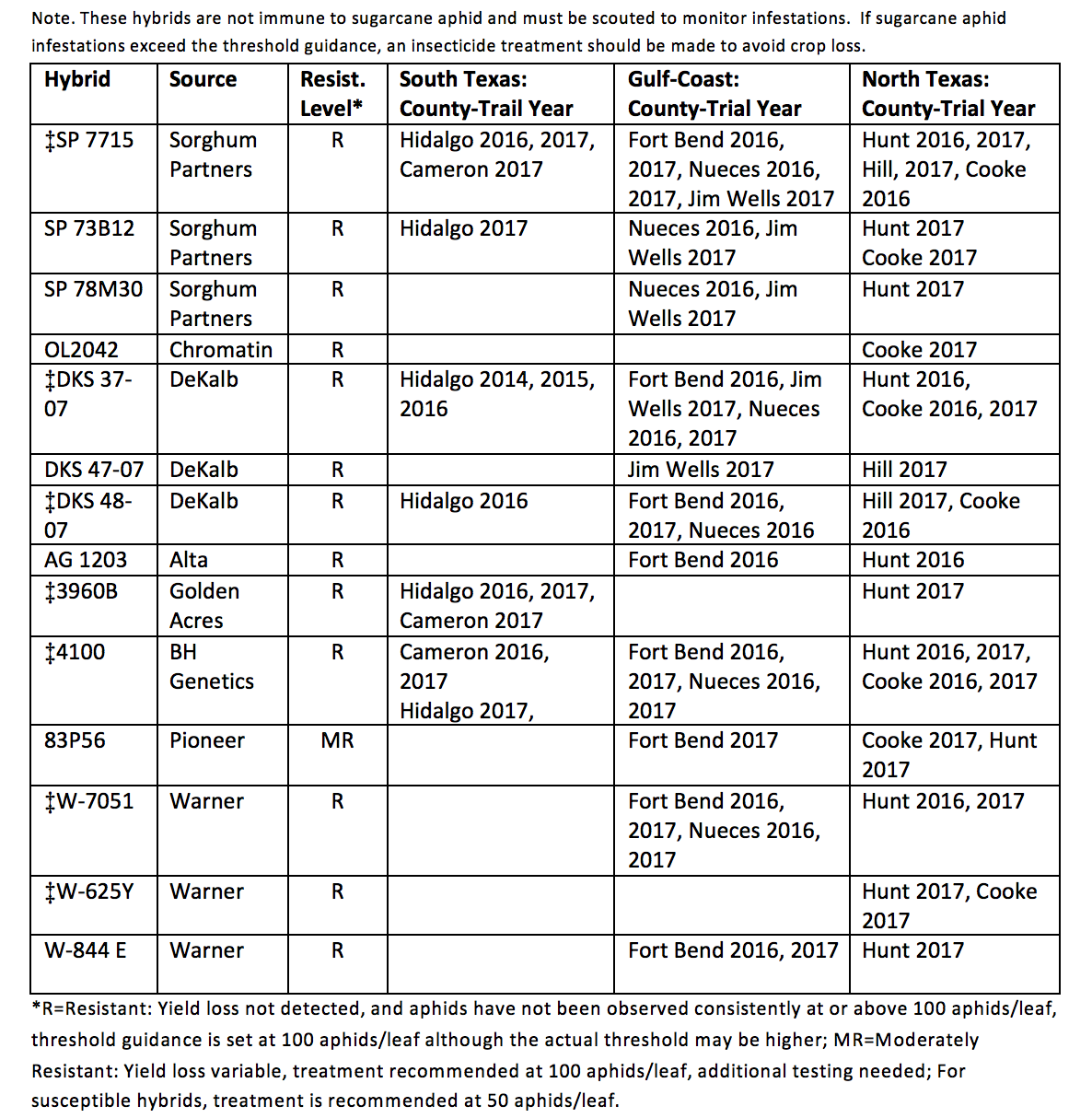
Contributors: Mike Brewer, Robert Bowling, John Gordy, Allen Knutson, Danielle Sekula-Ortiz, Texas A&M AgriLife Research and Extension.
Grain Sorghum Hybrid Tolerance to Sugarcane Aphid
This tip was provided by:
Calvin Trostle, Extension Agronomy, Lubbock, 806-746-6101, ctrostle@ag.tamu.edu
Allen Knutson, Extension Entomology, Dallas, (972) 952-9222, allen.knutson@ag.tamu.edu
Ron Schnell, Extension Agronomy/TAMU Dept. of Soil & Crop Sciences, College Station, (979) 845-2935, ronschnell@tamu.edu
Statewide
Grain Sorghum Hybrid Tolerance to Sugarcane Aphid
In this Sorghum Tip we will share results of different assessments of grain sorghum hybrids to SCA across the state. We have observed dramatic results of hybrid tolerance in many trials (Fig. 1). We will follow with specific in-season control measure later. In fact, many sorghum acres in South Texas are already planted, and seed decisions have been made, but much of the hybrid data below only became available this past week.
What will happen with sugarcane aphid in Texas in 2018?—No one can say for certain. We don’t know. But we do understand SCA well and that will help us all adjust to what SCA does in 2018, and we are in a far better position than we were in 2015.
Pre-plant Considerations for Potentially Reducing the Impact of SCA
Though most producers will think of insect control measures to involve scouting protocols, thresholds, insecticide choice and timing, method of application, spray carrier volume, and re-scouting (all to be discussed in greater detail in a future Sorghum Tip), here are early considerations. We thank Texas A&M AgriLife Extension entomologists for the suggestions:
- If planting grain sorghum it is our opinion that you should agree you will spray if science and extension recommendations call for it. Some producers in the Texas south plains in 2017 had good dryland sorghum, yield potential above average, but were adamant they would NOT spray. That strategy, if you want to call it that, cost some producers tens of thousands of dollars in lost yield. If you indeed plant grain sorghum but be unwilling to spray, then the following three points are especially important.
- Plant early. This may be most applicable in the High Plains where the cropping season could be underway for two months or more before potential arrival of SCA. Don’t plant so early to risk sickly seedlings from cool weather and late freezes, but a couple of weeks earlier planting vs. your norm enables your sorghum to be at more advanced growth stages before potential infestation may occur. For South Plains growers, this could mean planting about the last 7-10 days of April, or near May 1 if in the Panhandle. If the same pattern occurred in 2018 as last year around Lubbock, late April sorghum (medium and especially medium-early hybrids) was heading when SCA arrived. Larger plants can tolerate the SCA better compared to a few aphids on a three- or four-leaf stage seedling.
- Seed insecticide. AgriLife entomologists generally recommend that seed insecticide treatments help control SCA at least 30 days and may offer a reduced level of protection (suppression) for another couple of weeks. The cost of a comprehensive seed treatment with insecticide (also includes fungicide) may add $40-50/bag, but at ~5 lbs. seed per acre (about 65,000-70,000 seeds per acre), that is $4-5/acre. High Pains dryland seeding rates of ~30,000 seeds per acre would reduce added seed costs to $2/acre or less.
- Plant a sorghum hybrid with documented tolerance from independent sources. But know this: 1) all sorghum hybrids should be assumed susceptible to sugarcane aphid at some level, and must be scouted, 2) the ability of an individual hybrid to perform well in the presence of SCA may be influenced (diminished) by environmental conditions. Likewise, is a high yielding hybrid that is susceptible something to avoid? That depends. If you have a hybrid that outperforms on your farm, is it worth the more likely potential cost of spraying if it becomes necessary? (See Fig. 2.)
Grain Sorghum Hybrids Demonstrating SCA Tolerance in Texas
First, the data will be revisited to potentially update High Plains information so watch for more results in the next two Sorghum Tips. The criteria for the information below is multiple sites across more than one year where SCA infestation occurred. Probably the best trials are where sets of replicated plots are maintained under both sprayed (e.g., near aphid free) and unsprayed conditions. This enables a comparison of the two yields. Also, in our trials I (Trostle) have certainly noted that some hybrids that were deemed tolerant didn’t look like it, suffering significant damage. So, know that this is not take-it-to-the-bank assured SCA tolerance let alone resistance. There are also likely several hybrids that have comparable SCA tolerance but have not been tested enough to document tolerance.
From Ron Schnell, Soil & Crop Sciences, College Station:
Numerous replicated plot and strip trials, many with weekly counts of sugarcane aphids on lower and upper leaves.
Tolerant—
- Dekalb 37-07
- Pioneer 83P56 (long maturity)
- B&H Genetics BH4100, BH 3616,
- Golden Acres 3960B
- Warner Seed W-7501 (tall, similar to forage sorghum), W-844-E
- Sorghum Partners SP7715, SP73B12, SP78M30
- Alta AG1203
- Dyna-Gro M74GB17
From Allen Knutson & Extension Entomology Colleagues:
Beginning in 2014, Texas A&M AgriLife Extension and Research, with support from the Texas Grain Sorghum Producers Board, began to evaluate some of these hybrids in replicated field trials to confirm resistance to sugarcane aphid. Trials were conducted in the Rio Grande Valley, Gulf Coast and north Texas and compared the number of sugarcane aphids and leaf damage among the hybrids and to hybrids known to be susceptible to sugarcane aphid.
These trials confirmed resistance in 14 hybrids from seven different seed companies (Table 1). This list is not complete and these and other seed companies may have hybrids with resistance to sugarcane aphid.
Sugarcane aphid populations increase more slowly on these resistant hybrids compared to susceptible hybrids where thresholds for insecticide use have been set at 50 aphids per leaf. Also, damage is lower on resistant hybrids compared to susceptible hybrids. In these trials, resistant hybrids had fewer sugarcane aphids than susceptible hybrids and aphid infestations often remained below the treatment threshold of 50 aphids per leaf for susceptible hybrids, and rarely exceeded 100 aphids per leaf.
From Calvin Trostle, Soil & Crop Sciences, Lubbock (preliminary);
Results are limited, but initial evaluations (full evaluation by end of March) suggest:
- Stronger tolerance: Dekalb 48-07 (we are told it will not be released on commercial scale), Dyna-Gro M74GB17, Pioneer 85Y34 (sharply distinct results but only confirmed to date at one other location where it was planted, Altus, OK), Warner W-7051 (tall medium long hybrid that looks more like a forage sorghum).
- Moderate tolerance: Dekalb 37-07, Sorghum Partners SP7715.
Table 1. Grain sorghum hybrids identified as having some resistance to sugarcane aphid in field trials Conducted by Texas A&M AgriLife Research and Extension entomology, 2015-2017. See the Texas Sorghum Assn. “Sorghum Insider”, Feb. 20, 2017, for AgriLife entomology’s comments on suggested SCA thresholds above 50 aphids per leaf to as high as 200 aphids per leaf for strongly tolerant hybrids (for Central and South Texas, hybrids marked with ‡ have suggested aphid thresholds of 150-200 per leaf).
Sorghum Physiology & Management V
This tip was provided by:
Calvin Trostle, Extension Agronomy, Lubbock, 806-746-6101, ctrostle@ag.tamu.edu
Statewide
Sorghum Physiology & Management V
This is the final article of five Sorghum Tips from Texas A&M AgriLife since last fall. The previous Tips are available at http://texassorghum.org/sorghum-tips, and cover the following topics:
- Sorghum planting pattern may affect later brace root development and standability pending sorghum planting in a furrow, flat, or on an elevated bed.
- Location of sorghum roots near the soil surface and N fertilizer application.
- Keys for optimizing grain sorghum production due to growing point differentiation.
- Environment and feeding insect potential may influence hybrid choice of panicle type.
Physiology Driven Sorghum Management Consideration #5:
- Mistake: Associating developing grain color with maturity.
Too often farmers may draw incorrect conclusions about grain development and maturity based on observations from around the field without checking grain maturity. Any producer should know that among different grain sorghum hybrids there is variation in mature grain color, and not all grain will achieve the obvious red or orange color (let alone a crème or white grain) that might be assumed to represent maturity.
Our observation is that when the seed in the head begins to take on an orange or reddish tint, the seed is most likely still at the milk stage. As a sorghum field develops further color that you readily observe from the edge of the field or passing by from a distance then the sorghum grain tends to be intermediate between milk stage and soft dough (we call this ‘mealy’ or ‘gel’ stage; pressing the seed with finger and thumbnail no longer produces any liquid, but seed contents are squeezed out). Some producers erroneously use field grain color as a gauge for one last possible irrigation if available, but this is not a reliable means of deciding to irrigate again. You must check grain stage of development and probe for remaining soil moisture. Mature grain is never defined by grain color, but by black layer development, which can vary by up to seven days in a larger panicle, and up to seven days between a primary panicle vs. a tiller panicle.
Furthermore, the direction which you observe a maturing sorghum field’s grain color may lead one to a different conclusion about the development of a field. Typically, sorghum panicles color more quickly on the sides facing the sun (Fig. 1A&B).
Sorghum Physiology & Management IV
This tip was provided by:
Calvin Trostle, Extension Agronomy, Lubbock, 806-746-6101, ctrostle@ag.tamu.edu
Statewide
Sorghum Physiology & Management IV
This is the fourth of five physiological Sorghum Tips AgriLife is sharing over fall and winter of 2017-2018. See the library of previous Sorghum Tips at http://texassorghum.org/sorghum-tips for the previous information.
The Grain Sorghum Panicle (Head)
Sorghum panicles or heads exhibit a range of appearance depending on the hybrid and growing conditions. Panicles can range from compact (tight) to semi-open (Fig. 1) to open (loose) (Fig. 2) depending upon the length of the primary branches of each spikelet. Compact panicles have short primary branches and loose panicles have long primary branches. Panicle length and seed number per panicle are dependent upon when floral initiation takes places. Adequate soil moisture and less stress will result in larger panicles and higher yield potential. Adverse conditions during flowering including hot dry winds can lead to reduced pollen viability with fewer grains (‘blasting’) developing.
Morphology driven sorghum management consideration #4:
Environment and feeding insect potential may influence hybrid choice of panicle type.
Loose panicle hybrids that are fast growing and dry down rapidly are generally more preferred in areas with higher humidity and greater panicle feeding insect pressure. Tight panicles may enable insects and worms to better hide from feeding birds. Likewise, tight panicles also reduce insecticide penetration for feeding worms and other insects that may move into the head (e.g., feeding sugarcane aphids). Furthermore, tight panicles are more likely to develop grain molds in humid environments due to poor drying within the panicle. This was an example given to me recently from Haiti where most U.S. grain sorghum hybrids suffer from tighter heads.) Most Texas producers probably don’t consider panicle type, but accept whatever hybrid is best adapted or recommended for their area regardless of panicle type (or plant or grain color).
Grain Sorghum Flowering
Flowering of grain sorghum panicles begins from the tip and moves downward, completing flowering in 4 to 7 days for typical size sorghum heads. The larger the head, the more likely producers should check grain maturity as defined by black layer at the bottom of the head (as well as on tillers, which may be later to bloom by several days vs. the main panicle).
Sorghum Physiology & Management III
This tip was provided by:
Calvin Trostle, Extension Agronomy, Lubbock, 806-746-6101, ctrostle@ag.tamu.edu
Statewide
Sorghum Physiology & Management III
This is the third of five Sorghum Tips AgriLife will share intermittently over fall and winter of 2017-2018. The first two discussed rooting issues and possible sidedressing applications in grain sorghum.
Physiology Driven Sorghum Management Consideration #3:
- Keys for optimizing grain sorghum production due to growing point differentiation.
Sorghum growers are often unaware of the connection between three sorghum management keys of production practices and growing point differentiation (GPD)—optimum timing of management is the purpose of capitalizing on and preserving grain sorghum’s yield potential. GPD is the process when the growing point switches over from producing another leaf to now developing the head, or panicle (Figs. 1 & 2). This process last for an individual head about 7 to 10 days. The number of spikelets (per head) and seeds (per spikelet) are determined, e.g. important component of yield potential. Unlike wheat (jointing) and other small grains (all members of the same family of grasses as are the sorghums), there is nothing external on the plant that would indicate this is happening. So, we need to rely on the calendar some to estimate when this is occurring, or cut the stems like in Fig. 2 to find the growing point.
Here are potential management keys that reflect the significance of GPD in grain sorghum production:
- Timing of in-season nitrogen fertilizer application. As nitrogen fertilizer is often applied after planting, most U.S. production guidelines recommend ensuring that the bulk of N is applied in advance or during GPD. This is similar to small grains production for the same reason: providing adequate N nutrition during GPD aids in ensuring sorghum panicle development is not limited thus setting higher grain yield potential earlier in the growth of the sorghum plant. Similar to irrigation noted below, nitrogen applied after completion of GPD will have less value for achieving maximum yield potential.
- Herbicide injury potential. Growth regulator herbicides dicamba and 2,4-D may injure the growing point, which is particularly sensitive during differentiation. In particular, many producers do not realize the connection between growth stage and label restrictions for several herbicides. Common labeling instructs growers to apply over-the-top applications of dicamba and 2,4-D no later than approximately 8” tall (this corresponds to about leaf stage 5, or five fully formed leaves). This stage of growth is approximately four weeks after emergence. At this point further applications of dicamba or 2,4-D in sorghum up to 15” tall—approximately leaf stage 7 to 8—should use a drop nozzle or hooded sprayer to minimize contact of the herbicide on the leaves and especially deposition in the whorl. This practice reduces the exposure of sensitive developing GPD tissues to herbicide and the potential subsequent injury in the developing head, which is above the soil line, but still well down in the stalk. Significant dicamba or 2,4-D injury may lead to blanking or sterility in the heads with little grain development.
- Timing of irrigation, if available. When conditions are droughty irrigation applied at or just before GPD will preserve the development of yield potential by setting higher spikelet number and potential seeds per head. Irrigation applied after GPD is still important for yield potential, but it will not affect potential head size. An objection raised by farmers in rainfed conditions is that, without irrigation, there is nothing they can do about moisture supply during GPD—not true: foremost, reduced seeding rates, which should be considered anyway for lower rainfall and potentially droughty conditions afford more moisture per plant, which will enhance potential head size; likewise, soil moisture conservation practices (reduced tillage, maintenance of crop residues on the soil surface) will enhance the desired outcome of GPD.
Summary:
The summation of management of grain sorghum around GPD is all about developing and retaining higher yield potential. The maximum potential number of spikelets and seeds per spikelet—a major component of maximum yield potential—represent up to 70% of sorghum’s final grain yield, and is a result based on the seed number determined during GPD over a period of seven to 10 days.


